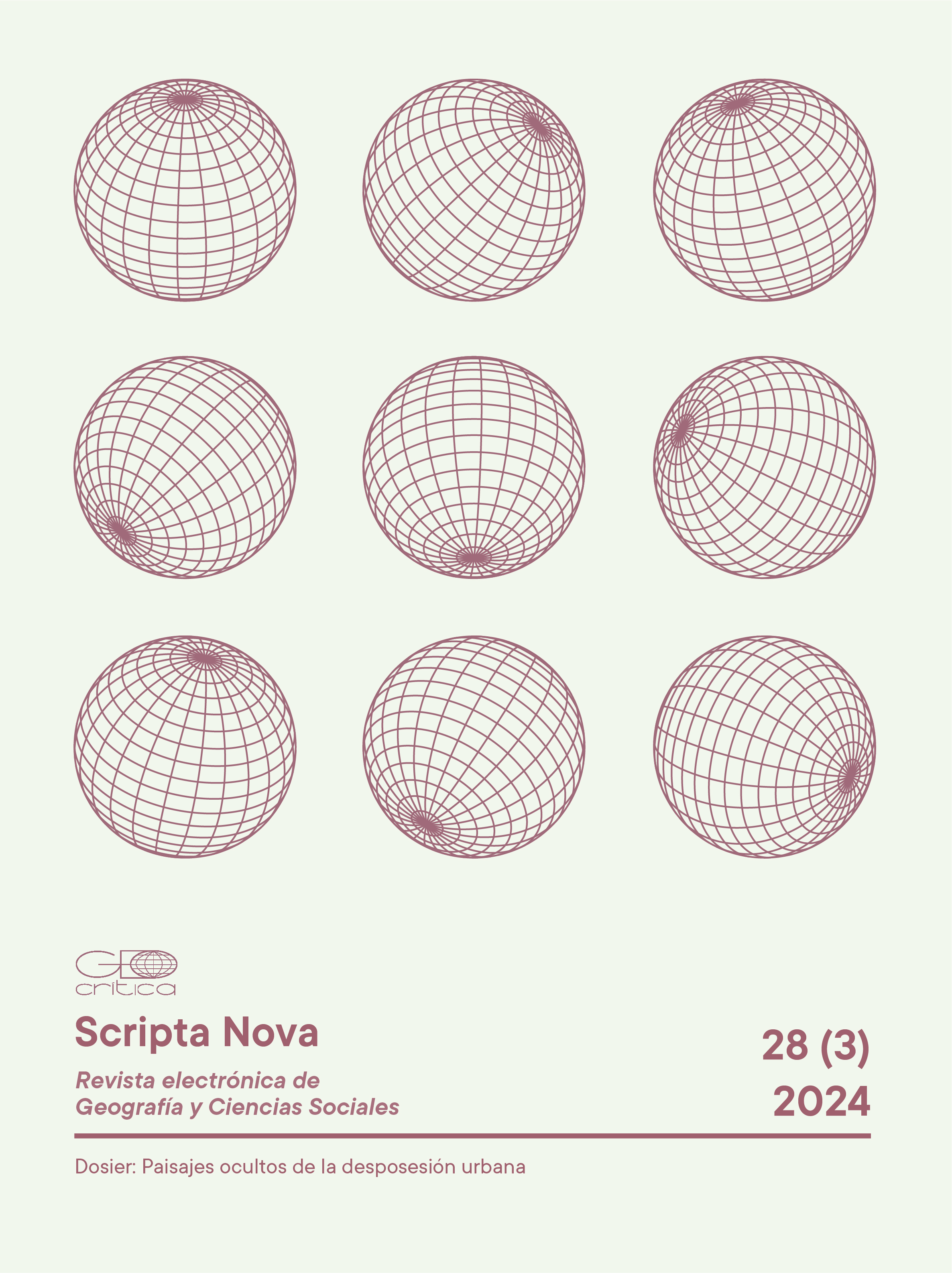It is not all “coser y cantar” . Exploring migrant women's domestic spaces
DOI:
https://doi.org/10.1344/sn2024.28.44851Keywords:
domesticity, migrant women, sewing workshop, textile life mapsAbstract
This article seeks to understand how people make a living on the urban margins through the domesticity of a group of migrant women who attend a weekly sewing workshop in Torrassa (L’Hospitalet de Llobregat). Despite their stories of struggle, migration and a reality marked by precariousness, they find in the workshop a socialising, mobilising and cathartic space; a valuable pretext for sharing yearnings and frustrations that transcend their own home, given that this does not stop being just another workspace where they carry their obligations, care and social reproduction. The domestic sphere here becomes a blurred concept, which diffuses the boundaries of the home, and whose activities strip women of their own space and time.
Through unusual qualitative research methods such as the creation of textile life maps we seek to delve into the chores and emotions of these women seamstresses and the complexities of inhabiting these places, highlighting their essential role in their homes and communities. Additionally, we aim to understand how, through their daily strategies of underlying and silent resistance, they sustain life on the margins.
References
Ajuntament de l'Hospitalet. 2022. Anuari estadístic de la Ciutat de L'Hospitalet 2022. L’Hospitalet de Llobregat.
Amoroso Miranda, María Inés, Anna Bosch Pareras, Cristina Carrasco Bengoa, Hortensia Fernández Medrano and Neus Moreno Sáenz. 2003. Malabaristas de la vida. Mujeres, tiempos y trabajos. Editorial: Icaria editorial. ISBN 10: 8474266742
Bayat, Asef. 2010. Life as Politics. How Ordinary People Change the Middle East. ISIM series on contemporary Muslim societies. Amsterdam: Amsterdam University Press.
Baylina, Mireia. 1997. “Metodología cualitativa y estudios de geografía y género”. Documents d’Anàlisi Geogràfica 30:123-38.
Berlant, Lauren. 2016. “The commons: Infrastructures for Troubling Times,” in Environment and Planning D: Society and Space 34, (3): 393–419. https://doi.org/10.1177/02637758166459.
Cearreta-Innocenti, Tania. 2023. “Life at the Margins: Women’s Everyday Practices as Resistance in a Working-Class Neighbourhood in Barcelona.” At the Frontiers of Everyday Life: New Research in Cramped Spaces. Springer Cham
Chaney, David. 2002. Cultural Change and Everyday Life. London: Palgrave.
Cotterill, Pamela. 1992. Interviewing women. Issues of friendship, vulnerability and powers. Women’s Studies International Forum 15 (5/6):593-606.
Guerrero, David. 2016. “L’Hospitalet quiere imitar a Brooklyn y ser un imán para el sector cultural.” La Vanguardia, December 15, 2016.
Goffman, Erving. 1961. Asylums: Essays on the Social Situation of Mental Patients and Other Inmates. New York: Anchor Books.
Hooks, bell. 1989. “Choosing the margin as a space of radical openness”. Framework: The Journal of Cinema and Media 36: 15-23.
Institut d’Estadística de Catalunya, IDESCAT. 2022. https://www.idescat.cat/
Katz, Cindi. 2001. “Vagabond capitalism and the necessity of social reproduction”. Antipode 33(4): 708–727.
Lawson, Victoria. 2008. “Geographies of care and responsibility.” Annals of the Association of American Geographers 97(1):1–11. https://doi.org/10.1111/j.1467-8306.2007.00520.x
Lefebvre, Henri. 1990. “An Inquiry, and Some Discoveries”. En Everyday LIfe In the Modern World. New Brunswick, NJ: Transaction Publishers (1st edn in French, 1968).
Margarit Segura, Daisy. 2008. “La inmigración latinoamericana en l’Hospitalet de Llobregat: una mirada desde lo cotidiano”. Quaderns d’estudi 1987, Núm. 20: 97 - 140.
McDowell, Linda. 2000. Género, identidad y lugar. Un estudio de las geografías feministas. Madrid: Ediciones Cátedra (Grupo Anaya, S. A.)
Olmedo, Élise. 2015. Cartographie sensible.Tracer une géographie du vécu par la recherche-création. PhD diss., Paris 1 Panthéon Sorbonne.
Olmedo, Élise. 2018. “Textile Maps. Using Sensitive Mapping for Crossovers Between Academic and Vernacular Worlds in the Sidi Yust Working-Class Neighbourhood in Marrakech”. This Is Not an Atlas : A Global Collection of Counter-Cartographies, 264-69.
Parker, Rozsika. 2010. The subversive stitch. Embroidery and the making of the feminine. London: I.B. Tauris. (1st edn in English, 1984).
Pérez Orozco, Amaia. 2014. Subversión feminista de la economía. Sobre el conflicto capital-vida.Madrid:Traficantes de Sueños.
https://doi.org/10.1017/CBO9781107415324.004.
Rolo González, Gladys, Dolores Díaz Cabrera and Estefanía Hernández Fernaud. 2009. “Desarrollo de Una Escala Subjetiva de Carga Mental de Trabajo (ESCAM).” Revista de Psicología del Trabajo y de las Organizaciones Vol. 25, n.° 1, 29-37.
Simmel, Georg. 1986. Sociología: Estudios sobre las formas de socialización. Madrid: Alianza Editorial. (1st edn in German, 1908).
Smith, Neil. 1996. The New Urban Frontier.Gentrification and the revanchist city. London: Routledge https://doi.org/10.4324/9780203975640.
The Care Collective. 2020. The care manifesto. London/New York: Verso.
Tello, Rosa. 2005. “Áreas metropolitanas: espacios colonizados”. In: Urbanizaçao e mundializaçao: estudos sobre a metrópoli, edited by Carlos AF, Carreras C, 9-20. Sao Paulo: Contexto.
Vaiou, Dina and Rouli Lykogianni. 2006. “Women, Neighbourhoods and Everyday Life”. Urban Studies 43 (4): 731-43. https://doi.org/10.1080/00420980600597434.
Wilson, Elizabeth. 1995. “The rhetoric of urban space”. New Left Review, n.o 209:146-60.
Downloads
Published
Issue
Section
License
Copyright (c) 2024 Tania Cearreta-Innocenti

This work is licensed under a Creative Commons Attribution-ShareAlike 4.0 International License.
Los autores que publican en esta revista están de acuerdo con los siguientes términos:
- Los autores conservan los derechos de autoría y otorgan a la revista el derecho de primera publicación, cin la obra disponible simultáneamente bajo una Licéncia de Atribución Compartir igual de Creative Commons que permite compartir la obra con terceros, siempre que estos reconozcan la autoría y la publicación inicial en esta revista.
- Los autores son libres de realizar acuerdos contractuales adicionales independientes para la distribución no exclusiva de la versió de la obra publicada en la revista (com por ejemplo la publicación en un repositorio institucional o en un libro), siempre que se reconozca la publicación inicial en esta revista.





